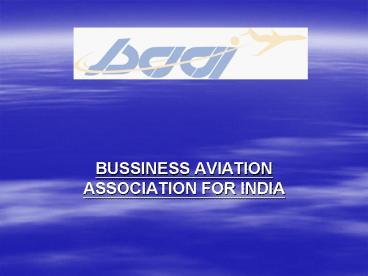BUSSINESS AVIATION ASSOCIATION FOR INDIA - PowerPoint PPT Presentation
1 / 16
Title:
BUSSINESS AVIATION ASSOCIATION FOR INDIA
Description:
One business jet to be added every third day for next 2 years. Fleet to triple in 2 years. ... air traffic control needs major improvement in terms of training ... – PowerPoint PPT presentation
Number of Views:48
Avg rating:3.0/5.0
Title: BUSSINESS AVIATION ASSOCIATION FOR INDIA
1
- BUSSINESS AVIATION ASSOCIATION FOR INDIA
2
BUSINESS AVIATION IN INDIA
- GREAT OPPORTUNITIES
- AND
- GREAT CHALLENGES
3
Agenda
- Overview of Indian Aviation
- Business Aviation In India
- What's driving the Growth?
- Whats holding us back?
- Challenges facing operators
- Are we moving forward?
- Questions
4
OVERVIEW
- Explosive Growth in Indian Aviation in 2005-06
Passenger traffic by 24, aircraft movement by
17 and freight traffic by 10 - Growth driven by economic growth, rising incomes,
growth of tourism, increasing competition,
emergence of low cost airlines, liberal
government policies etc. - Increasing competition and emergence of private
players means greater choice, higher quality of
service and lower prices.
5
OVERVIEW (Contd)
- Airport Segment just beginning to see private
sector participation - Delhi and Mumbai are being managed and
restructured by private companies in technical
collaboration with international partners. - As of now, airport infrastructure is woefully
inadequate. - Immediate need for existing airports to expand
and upgrade - India has a total of 455 airports and airstrips
only 135 of them are operational. Need to
revive/develop the rest. - As per current estimates, India needs USD 25
billion over the next 5 years to develop airports
6
OVERVIEW (Contd)
- Low Cost Airlines are playing an important role.
A whole new socio-economic group has entered the
market of airline travel. - Currently India attracts only 0.4 of global
tourism and 1 of total spending in tourism.
Tourism accounts for only 4.8 of GDP in India as
against 10.2 of GDP world wide - Next few years will see some consolidation and
shakedown in the Airline industry.
7
BUSINESS AVIATION IN INDIA
- The most neglected sector of Indian aviation
industry - There are no separate guidelines for GA aircraft
in India - Till 2005, there were only 50 business aircraft
to cater for a population of 1 billion people as
against USA - There is no concept of FBOs, heliports or GA
terminals in the country.
8
REASONS FOR POOR GROWTH OF GA SO FAR
- Lack of infrastructure
- Unfriendly government regulations. Long and
tedious procedures for purchase/import of
aircraft - Strict banking regulations tight control of RBI
- Conservative mindset of the older generation of
business leaders. This is changing with the
present set of younger entrepreneurs. - Lack of understanding on the value of corporate
aviation as business tool - Strict security norms
9
EXPLOSIVE GROWTH AHEAD
- GA is likely to grow by 30 to 40 as against
the overall growth of 25 - 2006 saw the fleet double.
- One business jet to be added every third day for
next 2 years. Fleet to triple in 2 years. - Present applications for import of 300 GA
aircraft pending with the Govt. 100 cleared last
year. - All major business houses and High Net worth
Individuals (HNIs) are joining the queue to
become aircraft owners. - Key change is that many medium (and some small)
companies are also buying A/C
10
WHATS DRIVING THE GROWTH
- Some De-regulation of Govt control.
- Easier finance available for aircraft purchase
- Change of mindset of new generation business
leaders tool vs. toy - Change in regulations for foreign investment in
Indian companies - Robust and booming economy (9). Availability of
extra purchasing power. - Global ambition of Indian companies. Need
creating demand
11
WHATS HOLDING US BACK
- Lack of Infrastructure. Airports lack parking
space, skies are overcrowded, - air traffic control needs major improvement in
terms of training and technology. - Regional connectivity is poor and regional hubs
need to be created. - Most of the smaller airports lack basic
facilities like VOR/ILS approaches and are at
best fit only for VFR flights. - There are inadequate international airports and
no FBOs or heliports in the country
12
WHATS HOLDING US BACK (Continued)
- Shortage of manpower There is tremendous
shortage of pilots, engineers, operational
personnel and ground staff in the aviation
industry. - This is unlikely to go away for the next 5 years.
India needs 5000 pilots, 25000 engineers and
about 100,000 aviation specialists from all
fields of aviation over the next 5-7 years - Present capacity is far below the demand e.g.
all the flight schools combined produce 150 CPLs
per year - GA suffers more than commercial aviation.
13
WHATS HOLDING US BACK (Continued)
- Government Regulations Though the govt is making
changes in the regulations, it needs to move at a
much faster pace on this. - Aviation in India is over regulated and needs to
free itself from govt shackles. - Acquisition committee, DGCA, BCAS, IB etc.
14
CHALLENGES FACING OPERATORS
- Complex and Difficult regulatory environment
- Step-child Treatment Commercial aviation takes
1st priority - Pressure from management/ clients
- Lack of Standards and procedures
- Severe shortage of manpower - Difficult to retain
key personnel - Until now no common voice BAAI hopes to
change this
15
ARE WE MOVING FORWARD
- Explosive Growth expected
- No. of Aircraft will increase rapidly
- Will the environment change fast enough to
sustain this? - Govt needs to play its part in policy making and
infrastructure development - Private participation in creating the right
environment and taking a lead in training the
manpower. - Nascent stage could very go wrong if growth is
not planned or nurtured
16
THANK YOU QUESTIONS ?































